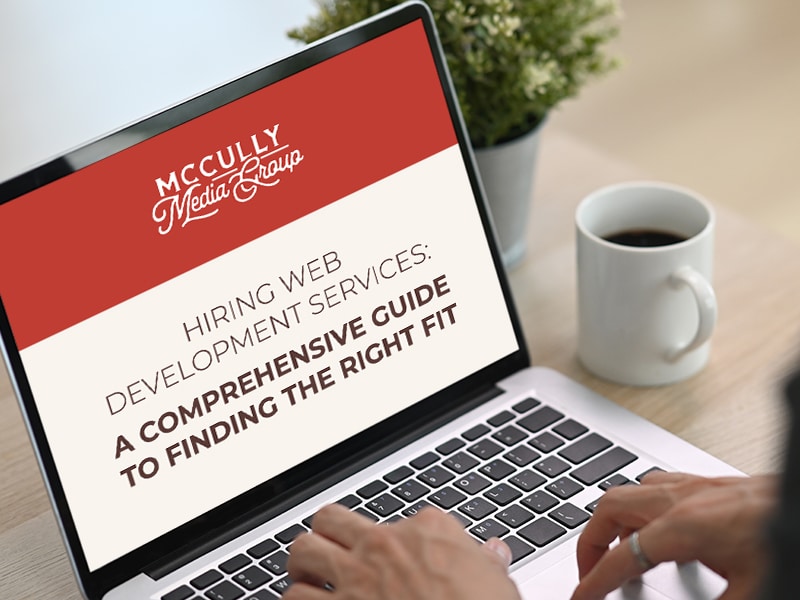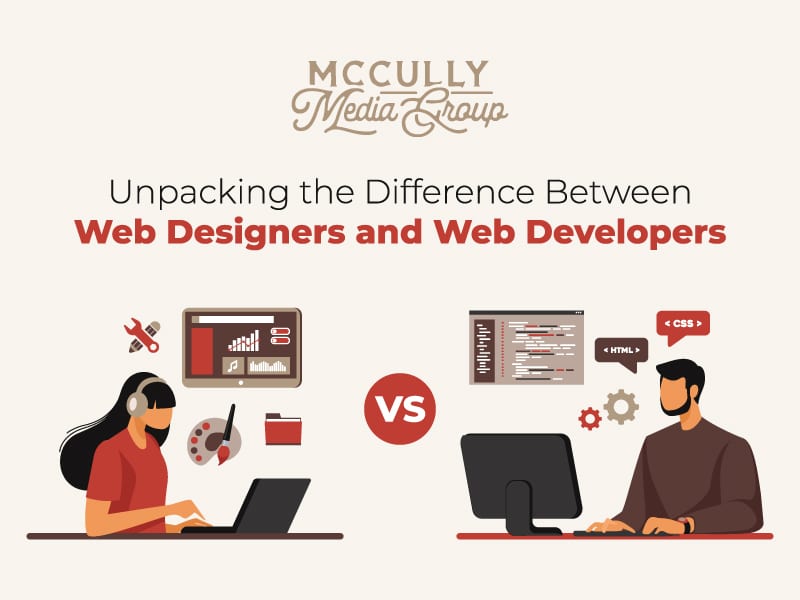You need a website but have no clue about how to build one? That’s where professional web development services from a professional web development company come in. But how do you identify the ‘right fit’ in an ever-growing sea of providers? With a systematic approach, as we outline in this guide, finding your perfect match becomes as simple as following a well-planned treasure map.
McCully Media Group, for instance, fuses technical web development prowess with the StoryBrand framework, creating an engaging narrative for your brand akin to a gripping Hollywood movie, where your customer is the hero who overcomes challenges with your company as their trusted guide.
Understanding the Different Types of Web Development Services
Navigating the world of web development services can be likened to constructing a building.
Front-end developers are the architects and interior designers of the digital realm, carefully designing and crafting the website’s visual elements that users interact with. They utilize tools like HTML, CSS, and JavaScript to construct a visually appealing facade and an inviting interior akin to a building’s architecture and interior design.
Back-end developers are like structural engineers, working behind the scenes to build the robust foundations and framework that support the website. They leverage programming languages such as Python, Ruby, or PHP to ensure the website’s stability, similar to how engineers ensure the building won’t crumble under pressure.
Full-stack developers are the master builders, possessing the combined skills of front-end and back-end developers. They are proficient in building a website from the ground up, harmoniously merging the facade and interior with the structural backbone.
Developing a Comprehensive Brief of Your Requirements

Startup Stock Photos | Pixabay
In the world of data and development, there’s a common saying, “Garbage in, garbage out.” This saying is particularly relevant when you’re preparing to hire web development services. A clear and comprehensive brief is akin to providing quality ‘input.’ Without it, you risk receiving a final product that doesn’t meet your needs — essentially, ‘garbage out.’
Your brief forms the foundation of your web development project, paving the way for a site that works for you. To ensure the brief is as effective as possible, it should encompass the following key elements:
1. The purpose: Start by articulating what you hope to achieve with your website. Are you aiming to escalate sales, expand brand visibility, or perhaps both? This objective will serve as the lighthouse, guiding all subsequent decisions in the web development process.
2. Your audience: Next, identify who your site is targeting. Providing detailed demographics of your target users, their typical online behavior, and their specific needs will ensure the final design and functionality resonates with them.
3. Desired features and functionality: Get specific about the features and functionality you want your website to have. This could range from a responsive design for mobile users to integration with certain databases or CRM systems.
4. Design preferences: Remember that the design of your website is crucial for the user’s experience. When creating your brief, mention any design elements you have in mind, such as color schemes, typography, or a specific layout.
5. Budget and timeline: Lastly, clarify your budget limitations and your expected project timeline. A clear indication of these aspects from the outset helps align expectations and ensures your chosen web development service can deliver within the defined constraints.
Finding the Right Web Development Company
When hunting for the right web development company, taking a structured and methodical approach can safeguard you from hiring a mismatched service provider — a mistake that can result in a myriad of complications.
Research with precision: Begin by drawing up a list of companies proficient in the specific web development services you require. Choosing a company ill-suited to your needs could lead to your vision being poorly executed or even not possible.
Scrutinize portfolios: Investigating the portfolios of potential companies is crucial. It provides an insight into their aesthetics and technical capabilities. Skipping this step could mean ending up with a website that doesn’t reflect your style or meet your functional needs.
Verify reviews and references: Trustworthy reviews and references offer a wealth of information about a company’s reliability. Neglecting this step can leave you vulnerable to working with a company that overpromises and underdelivers.
Engage in consultations: Personal discussions with potential companies can gauge their grasp of your project and their responsiveness. Proceeding without this assessment may result in miscommunications, leading to a final product that falls short of your expectations.
Remember, hiring the wrong web development company could mean facing delays, unexpected costs, and a website that doesn’t meet your requirements.
Assessing Your Web Development Options

Ronald Candonga | Pixabay
When assessing your web development options, looking beyond just the surface-level factors is important. Here are several key aspects to consider:
Technical capabilities: Take a deep dive into the company’s technical skills. Do they have the expertise in the specific platforms or languages necessary for your project? Does the company have the necessary expertise and experience to handle complex web development projects, such as eCommerce integration, data encryption, and mobile app development?
Communication skills: Does the web development company have clear communication channels? Are they able to translate complex technical jargon into layman’s language, ensuring you fully understand the process, decisions, and outcomes? Misunderstandings or miscommunications can derail a project, so it’s critical the company you choose can articulate clearly and effectively.
Cost structure: Understanding the company’s cost structure is crucial. Are their charges competitive and reasonable for the market? Do they offer fixed project pricing, or do they charge on an hourly basis? Does the quote include elements such as ongoing maintenance and updates? A transparent and comprehensive cost structure can help prevent surprises down the line.
After-service support: The relationship with a web development company doesn’t end once the website is launched. There should be after-service support for troubleshooting, updates, and maintenance. Can the company provide this? Do they have a structured plan for handling updates and bug fixes?
Evaluating the Cost of Web Development Services
Evaluating the cost of web development services can be likened to picking out a vehicle. Just as cars vary in price depending on their features, performance capabilities, and brand reputation, so too do web development services fluctuate based on the project’s complexity, the company’s experience, and the project deadline.
Just as you collect quotes from different dealerships when purchasing a vehicle, it’s essential to obtain estimates from various web development companies when embarking on a web project. This allows you to compare prices and what each service package encompasses.
Understanding How to Best Utilize the Services You Receive
Your newly minted website is a comprehensive digital platform meticulously engineered to bolster your online presence. The web development services you’ve availed extend beyond the construction of this platform; they are instrumental in helping you grasp how to manage and sustain it proficiently.
It’s crucial to comprehend how each component of your website can contribute to achieving your business objectives. This may involve learning how to deploy built-in analytics to trace user behavior, understanding how to revise content to retain freshness and relevance, or employing SEO strategies that were interwoven during the development process to amplify your site’s visibility.
Additionally, it’s valuable to consider the post-launch services that your web development company offers. Routine maintenance, updates, technical support, and consulting services are as essential as the initial website construction.
Conclusion
The process of hiring web development services might seem like navigating an intricate labyrinth at first glance. Yet, when you break down the steps, as we’ve done in this guide, the path toward finding the perfect fit becomes a rewarding journey of discovery. Understanding the variety of web development services, articulating a comprehensive project brief, researching potential companies, assessing options, and appraising costs, all act as stepping stones on this journey.
Unique services like those offered by McCully Media Group, blending technical prowess with the StoryBrand framework, exemplify the high level of integration and customization that can set a provider apart. Remember, your journey doesn’t just end at hiring a service provider; it’s about forging a partnership that empowers your business with a compelling digital narrative, where your customers are the heroes, and your company is their trusted guide.
Schedule a free call today to see how we can help develop your online presence.
Learn More:
Essential Elements of a High-Performing Website




